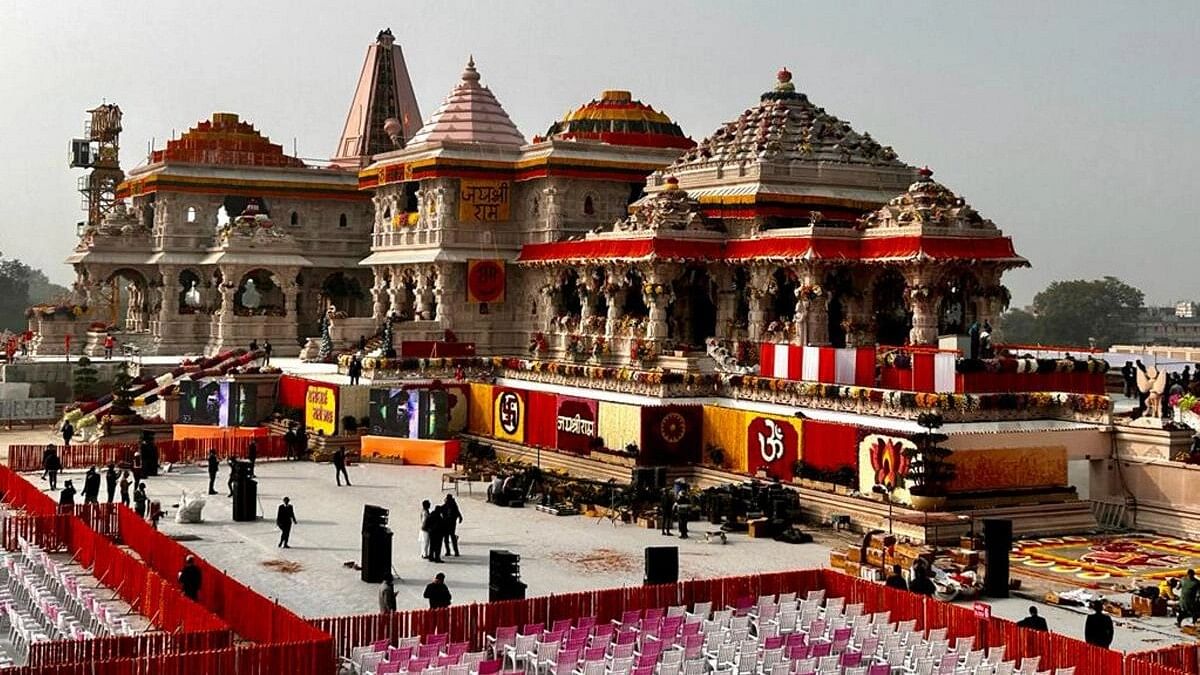
Ram temple being decorated with flowers on the eve of its consecration ceremony, in Ayodhya, Uttar Pradesh.
Credit: PTI Photo
As the country prepares for the 'Pran Pratishtha' ceremony of Lord Ram, karsevaks at Ayodhya feel a sense of achievement at the success of the Ram temple. Track our live coverage of the event here.
Karsevaks are people who volunteer their services for free to a religious cause, the term being derived from the Sanskrit words 'kar' (hand) and 'sevak' (servant).
Ayodhya-based karsevaks are a group who demanded the Ram temple in Ayodhya for over decades and struggled vehemently to achieve it.
In September 1990, the Vishwa Hindu Parishad (VHP), the Rashtriya Swayamsevak Sangh (RSS), and the Bhartiya Janata Party (BJP) campaigned for the Ram temple to be built at the Ram Janmabhoomi site.
The situation took a grave turn when BJP leader L K Advani conducted a rath yatra, aiming to conclude it at Ayodhya.
A large crowd followed him and soon, a huge group was marching towards the disputed site. Uttar Pradesh's then-chief minister Mulayam Singh Yadav decided to thwart the procession and announced a complete lockdown in the state.
There was tension in the air on October 30, 1990, as the police had barred all bus and train services to Ayodhya but that did not deter the kar sevaks. They reached there on foot, and some swam across the Sarayu River. The disputed structure was barricaded and 28,000 personnel of the Uttar Pradesh Provincial Armed Constabulary were deployed in Ayodhya.
It was around 10 am when a large group of karsevaks headed towards the site, led by Vamadev, Mahant Nratyagopal Das and Ashok Singhal of the VHP. The police tried to stop them when a clash erupted.
Almost an hour later, a sadhu managed to gain control of an Armed Constabulary bus and drove it through the barricades, with others following on foot. A saffron flag was then hoisted on top of the Babri Masjid.
And then, tragedy struck. Acting upon government orders of the government, the security personnel fired on the crowd. Many people died from head wounds and there was a stampede at the Sarayu Bridge, which killed more people.
On November 2, the kar sevaks proceeded again towards the Babri Masjid and there was another clash.
The police tried to disperse the crowd with tear gas and baton charges. Some kar sevaks managed to reach the mosque and partially damaged it.
The police retaliated and opened fire for the second time in 72 hours. The kar sevaks were chased through alleys, and in one location, later named Shaheed Gali or Martyr’s Alley, police killed many kar sevaks.
Later, Mulayam Singh described the firing order as 'painful yet necessary as it was ordered by the High Court to maintain peace, law, and order till the judgment comes out'.
To escape arrest and police firing, many kar sevaks had taken refuge in a secluded area, now called the 'Karsevak Puram', which was around two km from the Janmabhoomi site and out of police bounds.
Disgruntled RSS and its affiliates involving about 1,50,000 kar sevaks vastly outnumbered the police cordon placed to protect the structure. The mob attacked the building with axes, hammers and grappling hooks. Within a few hours, the entire structure made from mud and chalk was levelled.
The incident changed the course of modern India's history and started a bitter battle between different factions who struggled to claim supremacy over the disputed land.
Here's a list of the kar sevaks who were killed:
The Kothari Brothers (from Kolkata)
Setharam Mali (from Jodhpur)
Ramesh Kumar (from Ganganagar)
Mahavir Prasad (from Faizabad)
Ramesh Pandey (from Ayodhya)
Vasudev Gupta (from Ayodhya)
Sanjay Kumar (from Muzaffarpur)
Professor Mahendranath Arora (from Jodhpur)
An unnamed sadhu
Rajendra Dharkar
Babulal Tiwari (From the village of Nemavar)